Some of the relevant previous posts and a few of the associated test swatches for quick comparisons:
Large scale mesh, a punchcard repeat adapted for electronic 4/21 Tuck setting used in both directions, one of 3 variations 
 Revisiting large eyelet lace, hand transferred (or not) 7/20
Revisiting large eyelet lace, hand transferred (or not) 7/20 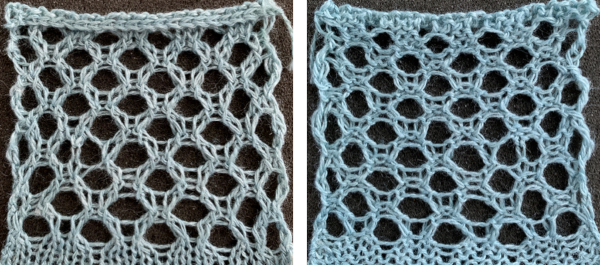 Large diagonal eyelet lace 6/12, electronic sample follows at the bottom of this post:
Large diagonal eyelet lace 6/12, electronic sample follows at the bottom of this post: 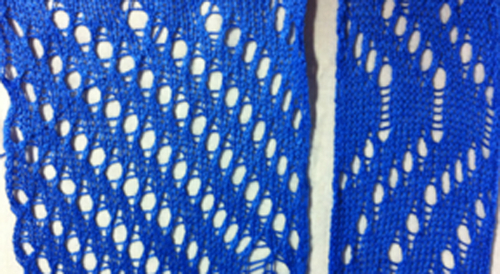 Large eyelet lace, hand transferred (or not) 9/13
Large eyelet lace, hand transferred (or not) 9/13  Large scale mesh, breaking the rules, the start of the explorations 4/11
Large scale mesh, breaking the rules, the start of the explorations 4/11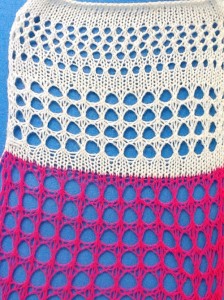 Single bed slits aka horizontal “button holes” 11/16
Single bed slits aka horizontal “button holes” 11/16 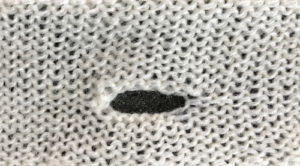 “Buttonholes” and “make many – increase” “lace” 5/15
“Buttonholes” and “make many – increase” “lace” 5/15  2024
2024
Seasonal knits inspired by published repeats 2_hearts
36X88 ![]()
 introduced a combination of standard and large eyelets along the edges of the shape for a better definition of the design.
introduced a combination of standard and large eyelets along the edges of the shape for a better definition of the design.
A recent FB share prompted a discussion of a different fabric combining selections by both the LC operating from the left, and the KC operating from the right, using the slip setting to secure the extra loops that result after a knit pass when side-by-side transfers are made in opposing directions.
When two carriages are selecting needles from opposite sides, each needs to clear past the respective set lines on the needle bed so as not to engage the belt while the other carriage is selecting and transferring or knitting, extension rails are a must.
Although this design repeat is 6 stitches in width, and in theory, it could be reproduced on a punchcard, it is not suitable for doing so.
On electronic machine models, each carriage pass advances the design by a single row.
When the alternate carriage is brought into action from the opposite side, punchcard models do not advance the card, repeating the last preselection, so the same stitch type is repeated for a second time. Some illustrations of the differences and contrasts can be found in the posts on doilies and edgings.
Planning the repeat in a spreadsheet helps to ensure that the direction of the lace carriage passes is kept accurate when the LC returns to selecting and transferring, as marked with the arrows on the left of the chart. The yellow cells and the arrows on the right reflect KC passes.  To knit: cancel end needle selection, KCII.
To knit: cancel end needle selection, KCII.
If any end needle is selected before a LC pass, manually push it back to the B position. If any end needle is not selected before a KC pass, push it out to D or E
position.
The LC, set to N, consistently makes 4 passes starting from and returning to the left, followed by 2 passes of the KC set to slip in both directions starting from and returning to the right.
On the 4th LC pass, as it moves from right to left all needles will be preselected forward, a clear marker that the next pass will be with the KC.
The repeat is 6 stitches in width by 24 rows in height. The empty cells on rows 12 and 22 will produce slip-stitch floats below skipped needles that secure the second loop formed by the side-to-side transfers.
This is the pixel or punched-hole configuration that produces the side-by-side transfers.
 The 6X24 png
The 6X24 png ![]()
The side-by-side empty needles  after the first pass with the KC to the left, with needles not selected, in B position, matching white cell placements in otherwise all black cell rows
after the first pass with the KC to the left, with needles not selected, in B position, matching white cell placements in otherwise all black cell rows  with slip-stitch floats holding down the first loop after the second KC pass as it returns to the right
with slip-stitch floats holding down the first loop after the second KC pass as it returns to the right 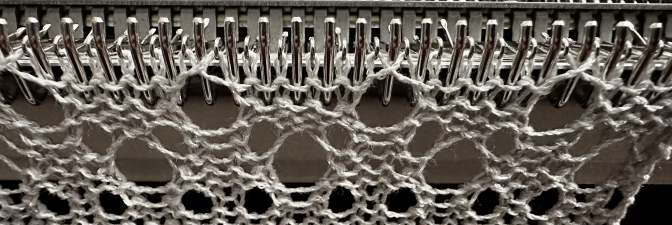 The proof of concept
The proof of concept  Pamela Cruse devised and shared another similarly mixed eyelet size knit. Her repeat is 6X16, with only the LC selecting needles, the KC remains set to knit, making it suitable for punchcard machines as well. The full card,
Pamela Cruse devised and shared another similarly mixed eyelet size knit. Her repeat is 6X16, with only the LC selecting needles, the KC remains set to knit, making it suitable for punchcard machines as well. The full card, 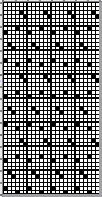 a single repeat,
a single repeat,  and the tiny PNG
and the tiny PNG ![]() The knit in progress: after the two side-by-side needles are emptied, the next KC passes produce two consecutive loops, the first does not stay on the needles, but rather, gets dropped, forming a float
The knit in progress: after the two side-by-side needles are emptied, the next KC passes produce two consecutive loops, the first does not stay on the needles, but rather, gets dropped, forming a float 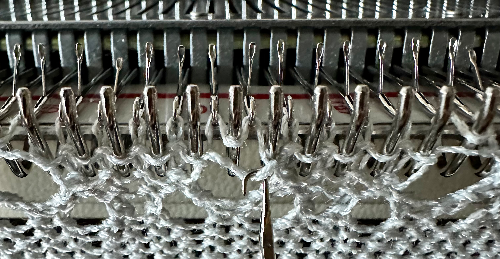 Needles will be preselected on each side of them, followed by transfers.
Needles will be preselected on each side of them, followed by transfers.  As those transfers are completed to the left and then to the right, it is those moved stitches that anchor down each loop.
As those transfers are completed to the left and then to the right, it is those moved stitches that anchor down each loop. 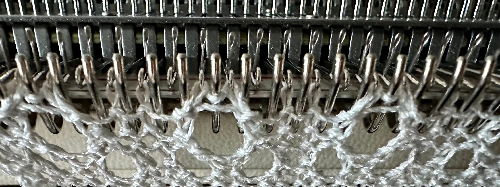 The first KC pass to the left forms single loops on the now empty needles,
The first KC pass to the left forms single loops on the now empty needles,  and the second KC pass to the right completes an all-knit row.
and the second KC pass to the right completes an all-knit row. 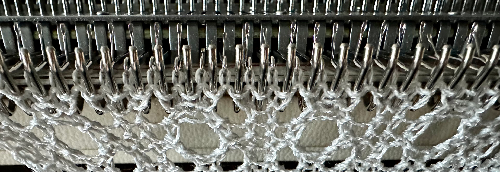 The process is repeated in brick configuration.
The process is repeated in brick configuration.
Mirroring horizontally was not required on the 930. When it was tested, an all-over single eyelet was produced, seen a the bottom of the swatch. 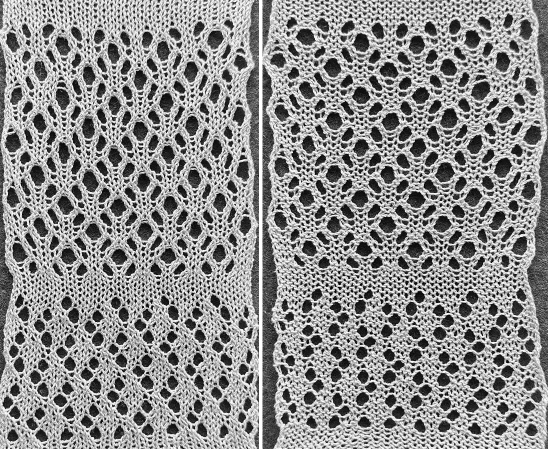 This large eyelet variation was developed by Claudia Scarpa, who shared these repeats for Brother machines which use opposite tuck/part buttons
This large eyelet variation was developed by Claudia Scarpa, who shared these repeats for Brother machines which use opposite tuck/part buttons  to form stitches properly after the side-by-side empty needle transfers have been performed.
to form stitches properly after the side-by-side empty needle transfers have been performed.
There are 2 versions, each beginning with 6 stitches X 16 rows design.
Aligning eyelets vertically 

![]() and in a brick arrangement
and in a brick arrangement 
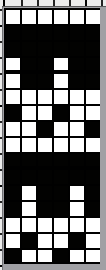
![]() To knit: cancel end needle selection, KCII.
To knit: cancel end needle selection, KCII.
If any end needle is selected before an LC pass, manually push it back to the B position. If any end needle is not selected before a KC pass, push it out to the D or E position. The LC, set to N, consistently makes 4 passes starting from and returning to the left, followed by 4 passes of the KC set to tuck to the left, slip to the right, starting from and returning to the right of the needle bed.
After the LC transfers have formed the double eyelets, when rows for the formation of tuck loops followed by slip stitch floats have been preselected, there will be pairs of needles brought forward to the D position.
The first KC tuck pass to the left forms tuck loops on the non-selected needles  the second slip pass to the right anchors the tuck loop as all needles are preselected for the pair of all knit rows that follow
the second slip pass to the right anchors the tuck loop as all needles are preselected for the pair of all knit rows that follow  The process is repeated with the eyelets forming in either orientation
The process is repeated with the eyelets forming in either orientation 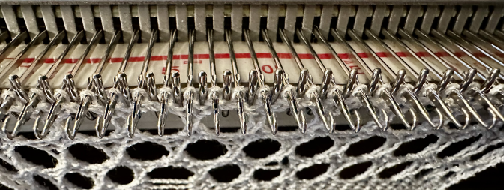 As the KC makes its last pass to the right there is no needle preselection, a sign that it is time to return to the use of the LC operating from the left
As the KC makes its last pass to the right there is no needle preselection, a sign that it is time to return to the use of the LC operating from the left  The vertically aligned repeat test swatch
The vertically aligned repeat test swatch  and the brick repeat test
and the brick repeat test 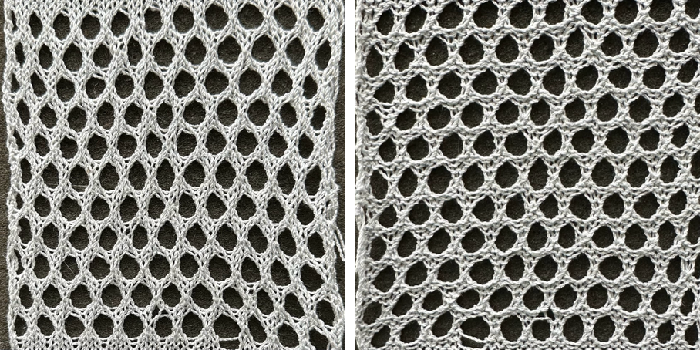 The 24X48 repeat for the diagonal mesh
The 24X48 repeat for the diagonal mesh
![]() The lace carriage makes 4 passes left to right followed by 2 passes of the knit carriage from right to left for the full repeat.
The lace carriage makes 4 passes left to right followed by 2 passes of the knit carriage from right to left for the full repeat.
The first KC pass creates double loops on the side-by-side empty needles 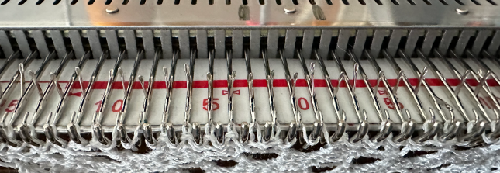 as it returns to the right, the first double loop is dropped, and a second double loop is formed
as it returns to the right, the first double loop is dropped, and a second double loop is formed  the next series of transfers will double up a single stitch on one of the two loops
the next series of transfers will double up a single stitch on one of the two loops  and the process is repeated as knitting progresses. The yarn used is knit wool rayon again, and the side edges were allowed to curl. There is one stitch that got away from me on the left.
and the process is repeated as knitting progresses. The yarn used is knit wool rayon again, and the side edges were allowed to curl. There is one stitch that got away from me on the left. 